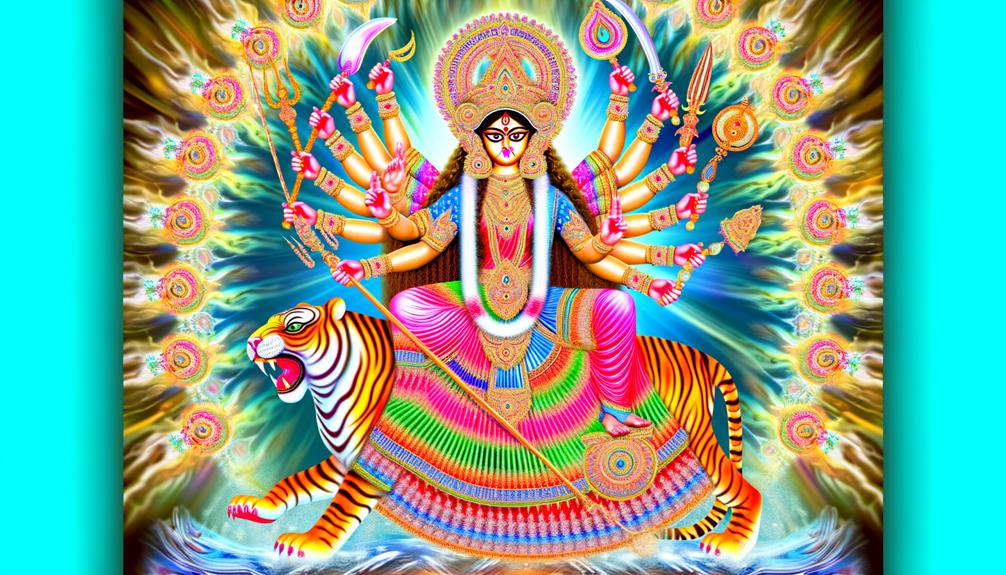Durga Name Meaning in English
The name 'Durga,' with its roots in ancient Sanskrit, translates to 'invincible,' combining 'dur' (difficulty) and 'ga' (to go). This name epitomizes the Hindu goddess Durga, symbolizing divine feminine power.
Durga's mythology presents her as a multi-armed protector embodying strength, fearlessness, and omnipotence. Celebrated through festivals like Navaratri, she signifies the triumph of good over evil.
In modern times, Durga represents female empowerment, influencing cultural norms and social values. To fully appreciate how this name impacts various facets of society and personal identity, exploring its rich historical and cultural context further is crucial.

Key Takeaways
- The name Durga means 'invincible' in English.
- Derived from the ancient Sanskrit word 'durgā,' combining 'dur' (difficulty) and 'ga' (to go).
- Signifies an entity that is difficult to conquer.
- Reflects Durga's role as a powerful, protective goddess in Hindu mythology.
- Embodies divine feminine power, strength, and fearlessness.
Etymology of Durga
The etymology of the name 'Durga' traces its roots to the ancient Sanskrit language, where it is derived from the word 'durgā,' meaning 'invincible' or 'unassailable.'
This linguistic origin underscores the profound reverence and formidable nature attributed to the deity Durga in Hindu tradition. The term 'durgā' combines 'dur,' signifying difficulty, and 'ga,' meaning to go or approach, epitomizing an entity that is difficult to conquer.
This conceptual foundation is reflective of Durga's role as a powerful and protective goddess, embodying strength and resilience against adversity. Through detailed philological scrutiny, scholars ascertain that the nomenclature encapsulates not just physical might but also a metaphysical representation of spiritual fortitude and unwavering resolve.
Symbolism in Hindu Mythology
Delving into the rich tapestry of Hindu mythology, one finds that the symbolism associated with Durga extends far beyond her martial prowess, encapsulating profound spiritual and philosophical dimensions.
Durga, often depicted as a warrior goddess, embodies the essence of Shakti, or divine feminine power. Her multi-armed form, astride a lion or tiger, symbolizes the ability to confront and vanquish multiple challenges simultaneously.
Additionally, Durga's emergence from the collective energy of the gods signifies unity and collaboration in the face of adversity.
Key symbolic elements include:
- Shakti (Divine Energy): Represents the fundamental creative force.
- Lion/Tiger: Symbolizes strength and fearlessness.
- Multiple Arms: Denotes omnipotence and the capability to perform myriad tasks.
- Emergence from Devas: Highlights the power of collective effort.
Attributes of Durga
Renowned for her multifaceted nature, Durga exemplifies a spectrum of attributes that convey her role as a protector, nurturer, and embodiment of divine energy.
Central to her identity is her invincible strength, symbolized by her multiple arms wielding various weapons, each representing different aspects of combating evil. Her serene yet formidable visage underscores her balance between ferocity and compassion.
Additionally, Durga's mount, the lion or tiger, signifies her mastery over power and courage. Her tenacity is mirrored in her name, which translates to 'the inaccessible' or 'the invincible,' highlighting her role as a formidable barrier against malevolent forces.
Through these attributes, Durga emerges as a powerful archetype of divine feminine energy, embodying both maternal care and warrior spirit.
Cultural Significance
Durga's profound attributes not only define her as a deity but also deeply influence her cultural significance, permeating various aspects of life, festivals, and social values within communities that venerate her.
Her multifaceted symbolism is embedded in numerous cultural practices and societal norms. Here are four key aspects of her cultural significance:
- Navaratri Festival: This major Hindu festival celebrates Durga's victory over Mahishasura, symbolizing the triumph of good over evil.
- Art and Iconography: Durga's imagery is prevalent in traditional and contemporary art, reflecting her power and protective nature.
- Literature and Mythology: Stories and hymns dedicated to Durga enrich the cultural literature, providing moral and ethical narratives.
- Social Values: Durga embodies strength and resilience, influencing gender roles and promoting female empowerment.
Durga in Modern Times
In contemporary society, the figure of Durga has evolved to embody modern ideals of female empowerment and resilience, influencing both public discourse and individual aspirations. Durga represents strength, independence, and the ability to overcome adversity, qualities that resonate deeply in today's socio-political climate. The goddess has become a symbol for various movements advocating for gender equality and women's rights. This modern relevance is captured through various cultural expressions, including literature, art, and social media campaigns.
| Aspect | Modern Representation |
|---|---|
| Empowerment | Advocacy for women's rights |
| Resilience | Overcoming societal challenges |
| Inspiration | Role model in contemporary media |
Durga's modern-day significance transcends traditional worship, serving as an inspirational archetype for contemporary women.
Conclusion
Durga, a central figure in Hindu mythology, embodies the triumph of good over evil. Symbolizing strength and protection, Durga's attributes reflect a multifaceted deity revered across various cultures.
Importantly, the festival of Durga Puja attracts over 10 million devotees annually in Kolkata alone, underscoring her profound cultural significance.
Through detailed etymology, symbolic interpretation, and cultural analysis, the enduring relevance of Durga in both historical and modern contexts is evident, demonstrating her timeless appeal and influence.






